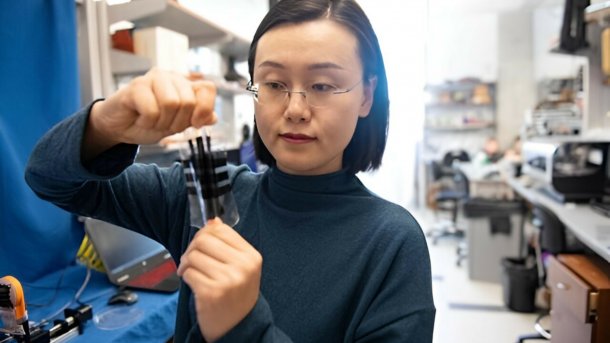New stretchable robot skin prevents tactile measurement errors
Artificial skin by Texan researchers is stretchable but avoids the issue of inaccurate knife bite simulations, offering precise tactile feedback.

Professor Nanshu Lu shows the stretchable artificial skin with integrated hybrid sensor.
(Bild: University of Texas)
Scientists at the University of Texas (UT) have developed what is probably the first stretchable electronic skin that delivers high measurement accuracy despite its elasticity. The artificial skin could help robots to perceive their environment with greater tactile precision, for example with touch-sensitive hands. Such robots could be used wherever they need to be able to react to touch, for example in care.
Artificial robot skin must be stretchable and flexible, but at the same time be able to recognize touch with a high degree of accuracy. The technologies developed to date have not succeeded in combining these two requirements. Now scientists from Austin, Texas, have developed a technology that fulfills both requirements, as they describe in the scientific paper "Stretchable hybrid response pressure sensors", which has been published in the journal Matter.
"Similar to how human skin needs to stretch and bend to accommodate our movements, so does the e-skin," says Nanshu Lu, professor in the Department of Aerospace Engineering and Engineering Mechanics at the Cockrell School of Engineering and leader of the project. "No matter how much our E-Skin stretches, the pressure response does not change, and that is a great success."
The problem in developing the artificial skin was to prevent the measurement results from being negatively affected by stretching. This is because during deformation, compressive and tensile forces are exerted simultaneously, generating noise that affects the sensors' ability to measure only the desired tactile pressure. In practice, this could lead to a robot equipped with these sensors gripping too tightly, for example.
Hybrid sensor for artificial skin
The researchers are using a hybrid reaction pressure sensor for their artificial skin, which they say they have been working on for several years. The sensor combines capacitive and resistive pressure detection at the same time. Both types of detection are used under pressure, while only the capacitive method is used for tensile forces. Under tension, the measured forces are then negated. The scientists combined the sensor with stretchable insulating and electrode materials to create the artificial, pressure-sensitive skin.
The scientists at UT are now working on finding potential areas of application for the robotic skin. Together with researchers from the Department of Computer Science in the College of Natural Sciences, they are currently building a robotic arm equipped with the artificial skin. Another area of application is, for example, care robots, which must have special tactile skills when handling patients in need of care so as not to injure them.
The UT researchers have submitted a provisional patent application for the technology. Lu and his colleagues are also looking for cooperation partners from industry, especially robotics companies, to bring the artificial skin to market.
(olb)